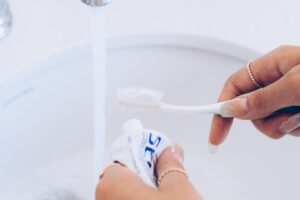Toothpaste is an essential part of our daily routine, helping us maintain clean teeth and fresh breath. But one important question that often comes up is: Does toothpaste actually kill bacteria and germs? Understanding how toothpaste works, especially in terms of its ability to fight harmful bacteria, can help us make better choices for our oral health.
This article will explore whether toothpaste can kill bacteria, what ingredients make toothpaste effective, and how different types of toothpaste work to protect your teeth and gums.
What is the Purpose of Toothpaste?
Before diving into whether toothpaste can kill bacteria, it’s important to understand the basic purpose of toothpaste. Toothpaste is designed to clean your teeth, remove plaque, prevent cavities, and freshen breath. It contains a combination of ingredients that work together to achieve these goals.

Key Purposes of Toothpaste:
- Clean teeth by removing food particles and surface stains.
- Prevent cavities by providing fluoride, which strengthens enamel.
- Reduce plaque and tartar buildup to protect your teeth and gums.
- Freshen breath with ingredients like mint or other flavors.
However, one of the most important aspects of toothpaste is its role in helping fight bacteria. The bacteria in your mouth can lead to issues like cavities, gum disease, and bad breath. So, toothpaste doesn’t just clean—it helps protect your teeth and gums from harmful germs.
Does Toothpaste Actually Kill Bacteria?
While toothpaste is designed to fight bacteria, it doesn’t usually kill all the bacteria in your mouth. Instead, it helps reduce the amount of bacteria, particularly harmful ones, that can cause tooth decay and gum disease. Toothpaste works primarily by disrupting the growth of bacteria, making it harder for them to stick to your teeth and gums. This, in turn, helps prevent plaque buildup and cavities.

Most toothpaste contains fluoride, which strengthens tooth enamel and makes it more resistant to acid attacks from bacteria. Some toothpaste also includes antibacterial agents like triclosan, which has been proven to kill certain bacteria. However, it’s important to note that many types of bacteria in your mouth are actually beneficial and necessary for oral health, so toothpaste doesn’t aim to wipe them all out.
How Toothpaste Fights Bacteria:
- Fluoride helps protect teeth from the damage caused by bacterial acids.
- Abrasives in toothpaste scrub away plaque, which contains bacteria.
- Antibacterial agents in some toothpastes can kill or reduce harmful bacteria.
Are Toothpastes Antibacterial?
Some toothpastes are formulated with antibacterial properties, while others focus more on cleaning, whitening, or strengthening enamel. Toothpastes that are specifically labeled as antibacterial usually contain ingredients designed to kill or inhibit the growth of bacteria in your mouth.
One common antibacterial ingredient in toothpaste is triclosan, which was widely used in many antibacterial products. Triclosan has been shown to be effective in reducing bacteria in the mouth and preventing gum disease. However, concerns over its long-term effects on health and the environment have led to it being phased out in many products.
Newer antibacterial agents, such as stannous fluoride and zinc citrate, are now commonly used in toothpaste to target harmful bacteria. These ingredients not only protect against cavities but also help to reduce gum inflammation and bad breath by fighting bacteria in the mouth.
Common Antibacterial Ingredients in Toothpaste:
- Triclosan: Once common, but now used less frequently due to safety concerns.
- Stannous Fluoride: A fluoride compound that also has antibacterial properties.
- Zinc Citrate: Helps reduce bacteria and prevent plaque buildup.
What is the Best Toothpaste for Killing Bacteria?
If you’re looking for a toothpaste that’s particularly good at fighting bacteria, you’ll want to look for products labeled as antibacterial or ones that contain stannous fluoride or zinc citrate. These ingredients can help reduce the number of harmful bacteria in your mouth while also providing other oral health benefits.

Some toothpaste brands have developed specific formulas to target bacteria and gum health. These toothpastes are often marketed as solutions for people with gum problems, such as gingivitis or periodontal disease. Here are a few popular options:
Toothpastes Known for Bacteria Control:
- Colgate Total: Contains stannous fluoride, which fights bacteria and protects against cavities, gingivitis, and bad breath.
- Crest Gum Detoxify: Formulated to neutralize harmful plaque bacteria along the gumline.
- Parodontax: Known for its ability to help control bleeding gums and reduce harmful bacteria.
When choosing toothpaste, it’s also important to consider your specific needs. Some people may need extra cavity protection, while others are more focused on fighting gum disease or bad breath.
How Does Fluoride Help Fight Bacteria?
Fluoride is one of the most common ingredients in toothpaste, and while it doesn’t kill bacteria outright, it plays a vital role in protecting your teeth from the damage caused by bacteria. Bacteria in your mouth produce acids that can wear down your enamel, leading to cavities. Fluoride helps strengthen the enamel, making it more resistant to these acid attacks.
Fluoride works by promoting the remineralization of your teeth. It encourages minerals like calcium and phosphate to bind to the enamel, which not only repairs weak spots but also makes your teeth stronger. While fluoride doesn’t kill bacteria directly, it does limit their ability to cause damage by reinforcing your tooth enamel.
Benefits of Fluoride:
- Strengthens tooth enamel to resist acid attacks.
- Promotes remineralization to repair early signs of decay.
- Reduces the ability of bacteria to harm teeth by making enamel more resilient.
Does Toothpaste Prevent Gum Disease?
Gum disease, also known as periodontal disease, is a common oral health issue caused by the buildup of plaque—a sticky film that contains bacteria—on the teeth and gums. If not removed, plaque can harden into tartar, which can lead to inflammation and infection in the gums.
Using toothpaste, especially one with antibacterial properties, can help prevent gum disease by reducing the amount of bacteria and plaque in your mouth. Some toothpastes are specifically formulated to protect the gums by targeting bacteria at the gumline. Ingredients like stannous fluoride and zinc citrate can help control plaque and reduce the risk of gum problems.
However, toothpaste alone isn’t enough to prevent gum disease. Brushing twice a day with a soft-bristled toothbrush, flossing daily, and seeing your dentist for regular cleanings are all important parts of maintaining healthy gums.
How Toothpaste Helps Prevent Gum Disease:
- Reduces plaque that can lead to gum inflammation.
- Fights bacteria that cause gingivitis (early-stage gum disease).
- Strengthens enamel to protect against decay near the gumline.
Does Brushing Your Teeth Kill All Germs?
Brushing your teeth with toothpaste helps to remove bacteria, food particles, and plaque, but it doesn’t kill all the germs in your mouth. Your mouth naturally contains billions of bacteria, some of which are harmful and some of which are beneficial. The goal of brushing is to reduce the amount of harmful bacteria and prevent them from causing issues like cavities and gum disease.

While toothpaste with antibacterial ingredients can help reduce the number of harmful bacteria, mouthwash is often more effective at killing a broader range of germs. Mouthwash, especially those with alcohol or chlorhexidine, can help reach areas that brushing and flossing may miss, providing additional protection against germs.
How Can You Maximize Bacteria-Fighting Benefits?
To get the most out of your toothpaste’s bacteria-fighting benefits, it’s important to use proper brushing techniques and maintain a consistent oral hygiene routine. Here are some tips to maximize the effectiveness of your toothpaste:
- Brush for two minutes: Spend at least two minutes brushing your teeth to ensure you remove as much plaque and bacteria as possible.
- Use a soft-bristled toothbrush: A soft brush will clean your teeth effectively without damaging your enamel or gums.
- Floss daily: Flossing removes bacteria and plaque from between your teeth, where a toothbrush can’t reach.
- Use mouthwash: Consider using an antibacterial mouthwash after brushing to kill additional germs and freshen your breath.
- Replace your toothbrush regularly: Change your toothbrush or toothbrush head every three to four months to ensure it’s working effectively.
Conclusion: Does Toothpaste Kill Bacteria?
While toothpaste doesn’t kill all the bacteria in your mouth, it does play a key role in reducing harmful bacteria and protecting your teeth from plaque, cavities, and gum disease. Toothpaste with antibacterial ingredients like stannous fluoride and zinc citrate can help kill or control bacteria that cause oral health problems.
To keep your teeth and gums healthy, it’s essential to brush twice a day with fluoride toothpaste, floss regularly, and see your dentist for checkups. With the right oral care routine, you can maintain a clean, healthy mouth and reduce the risk of bacteria-related issues.

